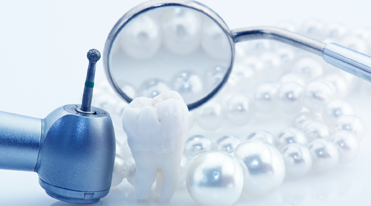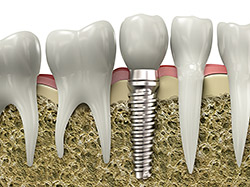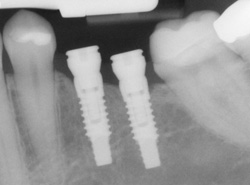
Your smile is one of your most important features. Dentistry is continually evolving, and with a variety of advanced treatment options, achieving a beautiful, healthy, aesthetic smile is made easy for patients of all ages.
If you've answered yes to any of these questions, cosmetic dentistry may be the answer you've been looking for!
Let us help you achieve your smile goals! Cosmetic dentistry is different from general dental care; it is both an art and science. By providing cosmetic dental care, your dentist is able to offer smile enhancement, restoration, and maintenance treatments for optimal dental health. Using cutting-edge techniques and advanced materials, our office proudly offers you a beautiful, natural smile and all the benefits that come with it.
Feel more confident about your appearance with a new smile that is as beautiful as it is healthy. You no longer have to suffer from missing, chipped, discolored, or crooked teeth. Contact our practice today and schedule your smile makeover!
Cosmetic dentistry combines both art and science to give you a healthy, aesthetic, flawless smile. While general dentistry is aimed at maintaining the health of your teeth and gums, cosmetic dentistry provides comprehensive treatment options that improve and preserve the way your smile looks and feels, Common cosmetic treatments include:
A cosmetic dentist is trained to safely and effectively provide a variety of treatments that are designed to enhance your smile. If you have missing teeth, you feel that your teeth are crooked, or you're an adult looking for an alternative to braces, a cosmetic dentist can help you achieve the beautiful smile you've always wanted.
Just as every smile we treat is unique, so are the treatments we provide. While cosmetic treatment times may vary, some treatments are completed within one office visit.
Insurance coverage and out-of-pocket expenses for cosmetic treatment vary. Our practice will work with you to provide several different treatment options, and we will coordinate with your insurance provider, if coverage is available. You will know all of your treatment costs up-front so that you can choose the best payment plan for your needs and your budget.
Patients who experience the most benefit from having their teeth whitened:
Teeth whitening is a safe, effective procedure, and does not typically include any negative side effects. Minor side effects may consist of:
Periodontics is one of the nine dental specialties recognized by the American Dental Association, focusing on the study and treatment of the soft tissue and bone supporting the teeth and jaw.
A periodontist is a dental specialist who has the training and experience required by the American Dental Association to diagnose, treat, and prevent different forms of periodontal/gum disease.
Periodontal disease, also known as gum disease, often begins as a buildup of plaque on the tooth's surface near the gum line. If this plaque is not removed by brushing and flossing regularly, it can harden into what your dentist calls tartar. Plaque will continue to build up over the tartar, eventually causing the gums to become red, swollen, and irritated. This is known as gingivitis and is the first stage of periodontal disease. If left untreated, gingivitis can turn into periodontal disease.
Periodontal disease, if left untreated, can contribute to other health problems including heart disease and diabetes. If you're pregnant, having periodontal disease is also linked to premature birth or low birth weight. Your smile's health affects the overall health of your body.
Gum disease is both preventable and treatable. Today's periodontal treatments provide you with a variety of options that are gentle, safe, and effective. If you have been diagnosed with gingivitis or gum disease, your periodontist can help you determine what treatment best meets your needs. Periodontal treatments include:
You may be at risk of having periodontal disease if you smoke or use tobacco products, you do not brush your teeth and floss regularly, you have health conditions such as diabetes, heart disease, or osteoporosis, or if several of your family members have had gum disease as it can, in some cases, be genetic. If you are experiencing any of the symptoms of gum disease, schedule an appointment with your dentist, who can help determine if treatment is necessary.
Many insurance plans will provide assistance for periodontal treatment. Our practice understands how important your dental health is, and we want you to get the most out of any dental treatment you receive. We will help you work with your insurance provider to make sure that your treatment is easy on your budget, and your peace of mind.
You no longer need to hide your smile because of gaps, chips, stains, or misshapen teeth. With veneers, you can easily correct your teeth's imperfections to help you have a more confident, beautiful smile. Veneers are natural in appearance and are a perfect option for patients wanting to make minor adjustments to the look and feel of their smile.
Veneers are thin, custom-made shells made from tooth-colored materials (such as porcelain) designed to cover the front side of your teeth. To prepare for veneers, your doctor will create a unique model of your teeth. This model is sent to a dental technician who creates your veneers. Before placing your new veneer, your doctor may need to conservatively prepare your tooth to achieve the desired aesthetic result.
When your veneers are placed, you'll be pleased to see that they look like your natural teeth. While veneers are stain-resistant, your doctor may recommend that you avoid coffee, tea, red wine, and tobacco to maintain the beauty of your new smile.

Crowns are a cosmetic restoration used to strengthen a tooth or improve its shape. Crowns are most often used for teeth that are broken, worn, or partially destroyed by tooth decay.
Crowns are "cemented" onto an existing tooth and fully cover the portion of your tooth above the gum line. In effect, the crown becomes your tooth's new outer surface. Crowns can be made of porcelain, metal, or both. Porcelain crowns are most often preferred because they mimic the translucency of natural teeth and are very strong.
Crowns or onlays (partial crowns) are needed when there is insufficient tooth strength remaining to hold a filling. Unlike fillings which apply the restorative material directly into your mouth, a crown is fabricated away from your mouth. Your crown is created in a lab from your unique tooth impression which allows a dental laboratory technician to examine all aspects of your bite and jaw movements. Your crown is then sculpted just for you so that your bite and jaw movements function normally once the crown is placed.

People are living longer than ever, and while regular brushing, flossing, and checkups allow many of us to maintain our natural smiles for a lifetime, sometimes our teeth just can't keep up. If you've lost a tooth (or a few teeth) due to injury or disease, dental implants can rejuvenate both your smile and your oral health.
An implant is a synthetic tooth root in the shape of a post that is surgically placed into the jawbone. The “root” is usually made of titanium: the same material used in many replacement hips and knees, and a metal that is well-suited to pairing with human bone. A replacement tooth is then fixed to the post. The tooth can be either permanently attached or removable. Permanent teeth are more stable and feel more like natural teeth.
The ideal candidate for implants is a non-smoker who has good oral health, including a sufficient amount of bone in the jaw, and healthy gums with no sign of gum disease.

Implants are versatile. If you are only missing one tooth, one implant plus one replacement tooth will do the trick. If you are missing several teeth in a row, a few strategically placed implants can support a permanent bridge (a set of replacement teeth). Similarly, if you have lost all of your teeth, a full bridge or full denture can be permanently fixed in your mouth with a strategic number of implants.
Conventional bridges and dentures are not fixed to the bone, and can therefore be unstable. This can make it difficult to eat or smile with confidence. Implants not only look more natural, but feel and act more like normal teeth, with a stronger biting force. And because they don't directly rely on neighboring teeth for support, implants don't compromise the health of your natural teeth. In fact, bridges are only expected to last seven to ten years, even less with root canals, whereas implants will typically last a lifetime.

Consider your replacement teeth to be the same as natural teeth. They require the same daily brushing and flossing, and the same amount of regular checkups. Just like your natural teeth, the better you take care of your replacements, the longer they will last.

Our implant services include:
Occlusal disease is caused by a misalignment or incorrect relation between the teeth of the upper and lower dental arches, also called malocclusion. If left untreated, occlusal disease can damage your teeth, the supporting bones and gums around your teeth, temporomandibular joints, and the jaw muscles you use for chewing. Many people dismiss excessive or abnormally accelerated tooth wear as "natural aging or wearing" of teeth, but your dentist can provide treatment to alleviate the pain and discomfort caused by occlusal disease.
Our goal is to preserve the oral health of our patients, as well as to anticipate the long-term results when restorative treatment is provided. Treating occlusal disease can lead to a long life of optimal oral health and restorative treatment success.
While most traumatic dental injuries occur in children and teenagers, people of all ages can be affected, usually as a result of sports mishaps, automobile accidents, or bad falls. If you've experienced a traumatic dental injury it is important to visit your endodontist in order to determine any necessary treatment. Any dental injury, even if apparently mild, requires examination by a dentist or an endodontist immediately. Sometimes, neighboring teeth suffer an additional, unnoticed injury that will only be detected by a thorough dental exam.
Chipped teeth account for the majority of dental injuries. Most chipped or fractured tooth crowns can be repaired either by reattaching the broken piece or by placing a tooth-colored filling. If a significant portion of the tooth crown is broken off, an artificial crown or "cap" may be needed to restore the tooth.
Injuries in the back teeth often include fractured cusps, cracked teeth, or a more serious split tooth. If cracks extend into the root, root canal treatment and a full coverage crown may be needed to restore function to the tooth. Split teeth may require extraction.
During an injury, a tooth may be pushed sideways out of or into its socket. Your endodontist will reposition and stabilize your tooth. Root canal treatment is usually needed for permanent teeth that have been dislodged and should be started a few days following the injury.
Children between seven and 12 years old may not need root canal treatment, since teeth are still developing. For those patients, your endodontist will monitor the healing carefully and intervene immediately if any unfavorable changes appear.
If a tooth is completely knocked out of your mouth, time is of the essence. The tooth should be handled very gently, avoiding touching the root surface itself. If it is dirty, quickly and gently rinse it in water. Do not use soap or any other cleaning agent, and never scrape or brush the tooth. If possible, the tooth should be placed back into its socket as soon as possible. The less time the tooth is out of its socket, the better the chance for saving it.
Once the tooth has been put back in its socket, your endodontist will evaluate it and will check for any other dental or facial injuries. If the tooth has not been placed back into its socket, your endodontist will clean it carefully and replace it. A stabilizing splint will be placed for a few weeks. Depending on the stage of root development, your endodontist may start root canal treatment a week or two later.
A traumatic injury to the tooth may also result in a horizontal root fracture. The location of the fracture determines the long-term health of the tooth. If the fracture is close to the root tip, the chances for success are much better. The closer the fracture is to the gum line, the poorer the long-term success rate. Stabilization with a splint is sometimes required for a period of time.
Chipped primary (baby) teeth can be aesthetically restored. Dislodged primary teeth can, in rare cases, be repositioned. However, primary teeth that have been knocked out typically should not be replanted. This is because the replantation of a primary tooth may cause further and permanent damage to the underlying permanent tooth that is growing inside the bone.
Children's permanent teeth that are not fully developed at the time of the injury need special attention and careful follow-up, but not all of them will need root canal treatment. In an immature permanent tooth, the blood supply to the tooth and the presence of stem cells in the region may enable your endodontist to stimulate continued root growth.
Resorption occurs when your body, through its own defense mechanisms, begins to reject your own tooth in response to the traumatic injury. Following the injury, you should return to your endodontist to have the tooth examined or treated at regular intervals to ensure that root resorption is not occurring and that surrounding tissues continue to heal.
With any traumatic dental injury, time is of the essence. Contact your endodontist immediately.